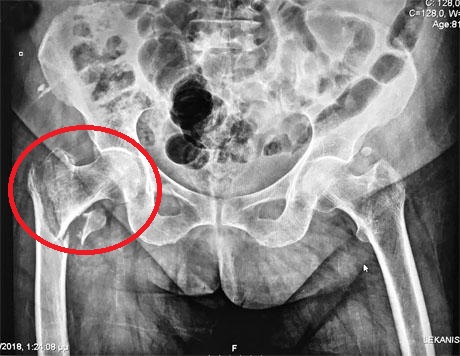
This is to keep you from getting pneumonia, bedsores, or blood clots, and to work on using the leg as much as possible. During the day you should sit up as much as you can. This decision is made on a case-by-case basis, and your doctor can explain why this would be necessary.Īfter surgery, it is very important to not just lie in bed. Occasionally a doctor may instruct a patient not to place any weight on their leg when it is healing. Depending on your living situation, you may need to live at a rehabilitation or care facility until you are strong enough to go home. While the break is healing, the patient is typically instructed by their doctor to place as much weight on their broken hip as is comfortable. Postoperative CareĪfter surgery, patients typically need to use a walker, crutches, or a wheelchair. Doctors may have a preference based on the injury pattern or their comfort level with the implants. Both implants can be used and produce good results. Image B shows an intramedullary short rod and screws. Image A shows screws and side-plate used to stabilize a broken hip. X-rays showing two different intertrochanteric fractures after surgery. This is close to where a hip-pocket is on your pants.įigure 4.
DISPLACED INTERTROCHANTERIC FRACTURE SKIN
The implant is placed through a cut in the skin on the outside of the patient’s hip. Typically, a metal implant is placed on or in the bone to hold the broken bone in the right position until the bone heals. The best treatment for these injuries is surgery to stabilize the break in the hip. Your doctor wants to make sure your health is as good as it can be before you undergo surgery. This may need to be evaluated with additional tests, particularly if they are on blood thinning medications. It is common for people who fall to also hit their heads. They need to be admitted to the hospital, as well as seen by other doctors to evaluate any other medical conditions and make sure they are okay to undergo surgery. People with broken hips usually need surgery to stabilize the broken bone. They will also typically need pain medication. When people come to the hospital with pain in their hip area, they will get an x-ray of their hip to see if and where it is broken. They are typically brought to an emergency room by ambulance. Initial CareĪ broken hip hurts, and most people cannot walk on their leg after they have broken their hip. The red arrows point to the breaks in the bone. X-rays showing three different examples of intertrochanteric fractures. Evidence-Based Medicine Resource List Overviewįigure 3.Video Library: Annual Meeting & Conferences.Sponsorship Right of First Refusal Guidelines.Exhibits & Marketing Partnerships Overview.
DISPLACED INTERTROCHANTERIC FRACTURE ARCHIVE

Disaster Management and Emergency Preparedness.The Issue of the Surprise-Billing Rules in Plain English.Research Survey Policy and Instructions.CNTR Early-Stage Investigator Travel Award Application.OTA Support of Federal Grant Applications.Research Volunteer Mentoring Program Overview.IOTA Special Issue: Orthopaedic Trauma Care: Global Approaches During a Pandemic.OTA SOMOS Military Traveling Fellowship Program.Fellow and Young Practitioner Resources.


 0 kommentar(er)
0 kommentar(er)
